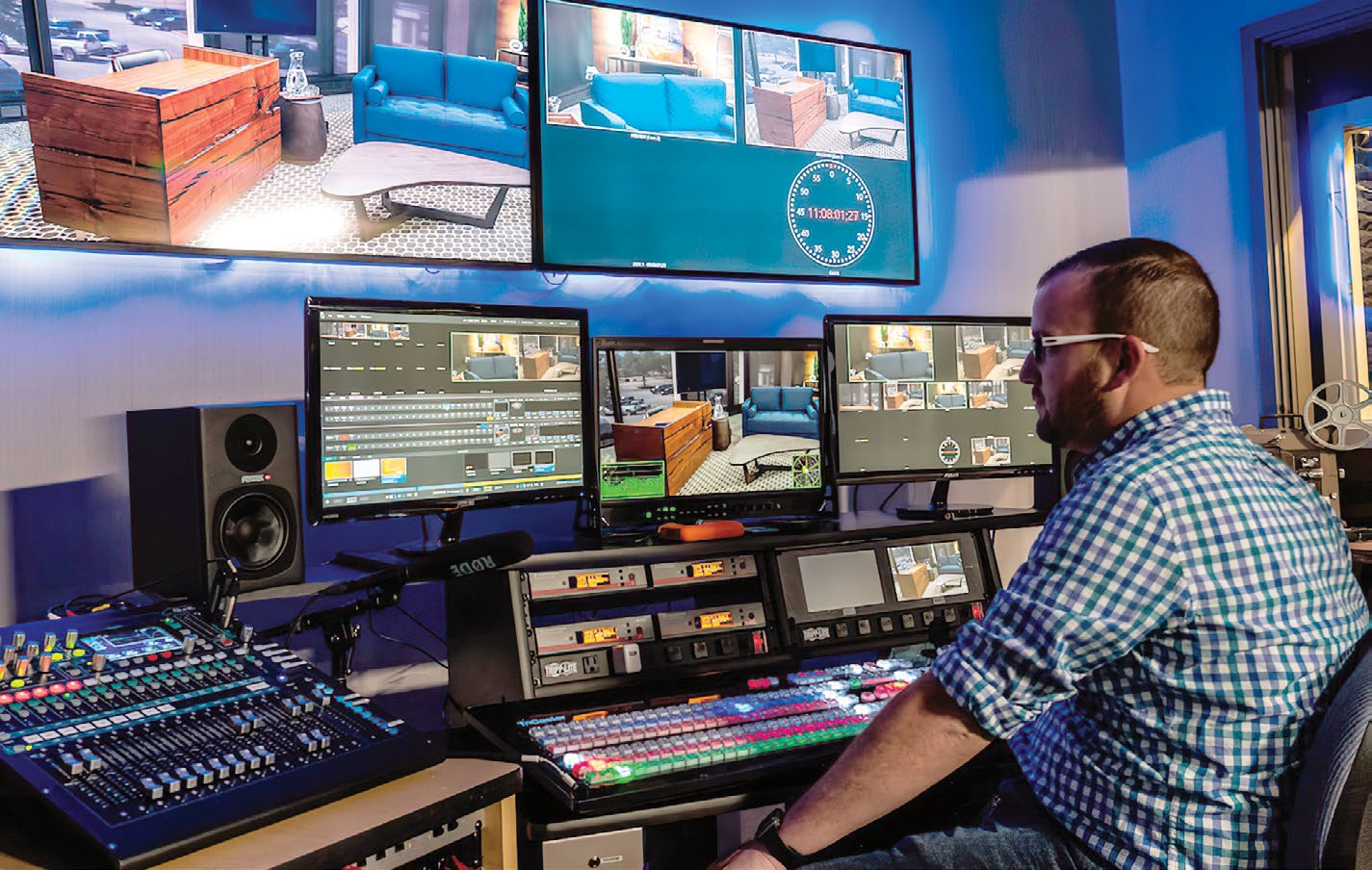Switchers Respond to Expanding Demands
ALEXANDRIA, Va.—Production switchers continue the industry trend of absorbing more functions in the quest to make operations easier, faster and more accurate. What used to be the province of selecting among cameras, recorders and remote feeds (with an occasional keyed title), is now a single-operator control station that can roll in pre-recorded material, interface with IP video, control cameras and program a broadcast.

And more functionality is on the way.
One of the biggest trends today is toward greater IP video capability according to Matt Allard, product marketing manager for NewTek.
“Migration to IP-based media production is now inevitable,” he said. “The timeline for various use cases will vary, but eventually will evolve in this direction just as the majority of media distribution already has. Just as with many other IT processes, there may be more than one standard to accomplish IP-based production, and users will choose which path best suits their price and performance needs.”
PROPER NETWORK BACKBONE
Speaking of standards, you need to be careful about how you plan to use IP in a new facility.
“For more compressed IP protocols like NDI, it almost as easy as plug and play,” said Tony Mastantuono, product manager at Broadcast Pix. “That said, any facility needs a proper network backbone—and if you’re considering uncompressed IP for broadcasters, that’s a whole different conversation. For the foreseeable future, SDI is not going away, but IP is becoming an attractive choice for long distances and remote production.”
The professional video industry's #1 source for news, trends and product and tech information. Sign up below.
As is often the case when new technologies enter the realm of an existing product category, it leads to features and applications that could not have been done with the original form of the product.

“IP connectivity… translates very well into one of the leading trends that we are seeing with switcher technology, which is production resource sharing,” said Deon LeCointe, senior manager for IP production and sports solutions at Sony Electronics. “Years ago, remote production burst onto the scene giving content creators the ability to deploy a reduced number of resources to cover events that demanded a lower budget. The advent of IP technology helped to drive that trend and it has now grown from just covering sporting events to also covering major events in entertainment and news.”
Now, content creators are looking at different ways to design or re-design their facilities using IP technology, Le-Cointe added.
“Instead of a specific resource, like a camera or switcher, assigned per studio or control room, they are looking at ways that the same resource could be shared across multiple studios, or even facilities,” he said. “More and more facilities are being integrated into enterprise-wide networks, which begs the question: ‘Can a switcher located in a broadcast center in New York be used to run an HD production located in Boise?’ We know the answer to that question is a resounding ‘Yes,’ but then you could also ask, ‘Can that same switcher be used to run a 4K show in New York simultaneously?’ With production resource sharing, the answer to that question is also ‘Yes.’”
IT’S NOT ALL IP… YET
Despite the general acceptance of IP connectivity, SDI is still widely used in the broadcast industry.
“We’re responding to the increased market demand for flexible systems that are capable of SDI and IP, which is certainly true when it comes to video switchers,” said Takaaki Imoto, director and senior general manager for the overseas sales and marketing division of FOR-A. “And while IP demand grows, we’re still in a transitional phase—we offer products that meet the needs of both IP and SDI.”
Greg Huttie, vice president for switchers at Grass Valley, agreed.
“While IP is undoubtedly gaining serious momentum across the industry, a lot of customers are still looking for solutions that are both SDI and IP friendly,” Huttie said. “What we’ve learned from talking to customers is that there isn’t a one-size-fits-all switcher.”
Other manufacturers also acknowledge that IP video is out there, but have their sights on different targets.
Although IP connectivity does have its place for certain workflows, it’s not a foregone conclusion, according to Bob Caniglia, director of sales operations for North America at Blackmagic Design, which launched its own 8K production switcher at the 2019 NAB Show.
“What’s more certain is 8K—even with its select use at present, such as with large Times Square and stadium-sized screens, NHK has been broadcasting in 8K for a year now,” he said. “Add to that the fact that NHK and others have announced 8K plans for the upcoming 2020 Olympics, and 8K will remain in the spotlight.
“The thought of 8K might sound reserved for a select few national broadcasters, but there are affordable and feature-rich switchers currently available that deliver HD, Ultra HD and 8K capability in a single unit,” Caniglia continued. “It’s not too early to plan for the future.”
Like Blackmagic Design, FOR-A has a variety of 8K products that include routing switchers, up/down converters, HDR/SDR converters and signal generators.
“We’ve successfully installed these in major TV stations in Japan,” Imoto said.
HIGH DYNAMIC RANGE
8K might be the wow that comes with major sporting events, but there is also good work being done at 4K and even HD resolution. In particular, some production manufacturers are working to include high dynamic range (HDR) technology into their switchers and other components in the video chain.
“Today’s consumers want stunning images that create a captivating viewing experience that is the next best thing to being there, and sometimes even better,” Grass Valley’s Huttie said. “HDR delivers perceivable improvements in image quality—even with HD—that deliver the wow factor viewers demand. Our customers tell us they want solutions that are format flexible and can be scaled, so we’ve built this functionality into our switchers from the beginning, allowing production teams to handle content in any mix of HD, 4K UHD, SDI, IP, SDR or HDR.”
Blackmagic Design is also building in a path to 8K without ignoring the current HD and 4K production environment.
“8K is on the horizon,” Caniglia said. “Many broadcasters are still working toward the transition to Ultra HD and have the eventual transition to 8K in the backs of their minds. They may not realize that they should start thinking about 8K now based on their current workflows and nearer-term investments. To help our customers, earlier this year we introduced a range of 8K broadcast workflow products, all of which are compatible with existing SD, HD and 4K workflows in addition to tomorrow’s 8K broadcast production.”
EXTRA FEATURES
Several switcher manufacturers also have cameras in their portfolios, which brings up the possibility that the switchers and cameras could talk to each other and provide extra features to streamline production tasks. “Across Grass Valley’s switcher portfolio we now have the ability to trigger from the switcher’s control surface scene files loaded from the camera,” Huttie said. “This is a truly handy capability when lighting changes occur, such as on news studio sets, for in-game interviews or when concert lighting changes. This capability allows normal field cameras to quickly adapt from covering the live action without the need to cut to a different camera.”
Sony is also working on solutions that build synergy when a customer uses both switchers and cameras from the company.
“Production environments that contain both Sony cameras and switchers really benefit when [our] control layers are applied,” LeCointe said. “For example, our ELC automation system enhances operational efficiency and newsroom productivity. It can control all elements of a live news production workflow including cameras, production switchers, layout and the newsroom computer system. Another control layer includes Sony’s new Live Element Orchestrator, or LEO. LEO enables smart IP workflows and optimizes use of resources through the remote setup, management and monitoring of all IP networked devices, including cameras, switchers, servers and monitors.”
However, don’t rule out the offerings from switcher-only manufacturers.
“Each market has its own unique requirements,” Broadcast Pix’s Mastantuono said. “For example, PTZ camera control is practically indispensable for government meeting coverage, while small-market broadcasters appreciate our built-in clip and graphic stores and Watch-Folders. Because Broadcast Pix is a more software-based system, we’re more flexible than hardware-based solutions on the market.”
ARTIFICIAL INTELLIGENCE
Making its way from science fiction to reality is the use of artificial intelligence in production switchers. At least a couple of companies are addressing AI in their switchers—FOR-A has developed an Automatic Objectives Tracking system with AI capability, which is used at horse racing and cycling tracks. The company plans to extend this AI technology to other products, including production switchers.
Sony does not have AI technology in its switchers today, LeCointe advises that the company will have announcements regarding AI in the future.
Higher resolution, more features, greater IP compatibility, integration benefits… all these are possible with the latest generation of production switchers. And although you may have thought that consolidation of networks and program outlets might reduce the need for production switchers, it appears the opposite is true—there is more content being created than ever, and more switchers are needed to create that content.
That is the finding of the Broadcast Switchers Market report by Transparency Market Research, which estimates that the market for switchers will grow at a 5% rate over the next couple of years. In particular, Transparency Market Research attributes this robust growth to the adoption of 4K production by content creators, studios and broadcasters across the world.
Production switchers are a thriving product category, despite the increased production being done by one-person producers with a camera and editing software. The global appetite for fresh programming is raising all production boats, including the sort of facilities that use production switchers.
That’s great news for people who enjoy watching television… and for switcher manufacturers.
Bob Kovacs is the former Technology Editor for TV Tech and editor of Government Video. He is a long-time video engineer and writer, who now works as a video producer for a government agency. In 2020, Kovacs won several awards as the editor and co-producer of the short film "Rendezvous."

